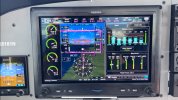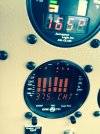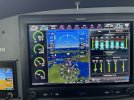Hello Everyone,
For this thread is important to mention I live in Panama City (Central America) and the weather here is 80ºF to 95ºF all year round. I fly a 1980 C182Q with recently installed all-six brand new Superior Millenium cylinders in February this year. After the cylinder change, as expected, the engine was running somewhat hot according to the instrumentation I had then (JPI EDM-700 and the original Cessna engine Instruments). Oil temperature would indicate anywhere between 190ºF - 200ºF and CHTs were above 400º on some cylinders steady during the entire trips. I flew like this for about 50hrs up until June when it went in for a panel upgrade.
Now I have upgraded my instruments to an all-glass Garmin G3X panel with new probes the values I see indicated have changed a lot. The indicated oil temperature is now very low while flying and the CHTs are also lower but not alarming lower.
The oil temperature is now indicating Between 122º and 130º in level flight at 6K-7K-8K feet with cowl flaps closed and leaned properly with lean assist. The highest it goes is 145º in climb out with full mixture. Cylinder head temperatures are in fairly reasonable range (340º the hottest, 210º the coolest in level flight at 65% power setting).
It it important to mention I removed, fixed and painted all engine baffles and put brand new baffle seals and so this may have helped reduce all temperatures but I still see the change too drastic.
So, I removed the oil temperature probe and tested it in water with a handheld thermometer and it indicates precisely as the thermometer did. Next I removed the vernatherm and checked it in hot water and, as it should, above 70ºC I noticed the contraction. The only thing I'm left without knowing is if when expanded it is fully expanded. Other than that I don't know what could be happening.
If anyone has any thought or ideas please share here.
For this thread is important to mention I live in Panama City (Central America) and the weather here is 80ºF to 95ºF all year round. I fly a 1980 C182Q with recently installed all-six brand new Superior Millenium cylinders in February this year. After the cylinder change, as expected, the engine was running somewhat hot according to the instrumentation I had then (JPI EDM-700 and the original Cessna engine Instruments). Oil temperature would indicate anywhere between 190ºF - 200ºF and CHTs were above 400º on some cylinders steady during the entire trips. I flew like this for about 50hrs up until June when it went in for a panel upgrade.
Now I have upgraded my instruments to an all-glass Garmin G3X panel with new probes the values I see indicated have changed a lot. The indicated oil temperature is now very low while flying and the CHTs are also lower but not alarming lower.
The oil temperature is now indicating Between 122º and 130º in level flight at 6K-7K-8K feet with cowl flaps closed and leaned properly with lean assist. The highest it goes is 145º in climb out with full mixture. Cylinder head temperatures are in fairly reasonable range (340º the hottest, 210º the coolest in level flight at 65% power setting).
It it important to mention I removed, fixed and painted all engine baffles and put brand new baffle seals and so this may have helped reduce all temperatures but I still see the change too drastic.
So, I removed the oil temperature probe and tested it in water with a handheld thermometer and it indicates precisely as the thermometer did. Next I removed the vernatherm and checked it in hot water and, as it should, above 70ºC I noticed the contraction. The only thing I'm left without knowing is if when expanded it is fully expanded. Other than that I don't know what could be happening.
If anyone has any thought or ideas please share here.



